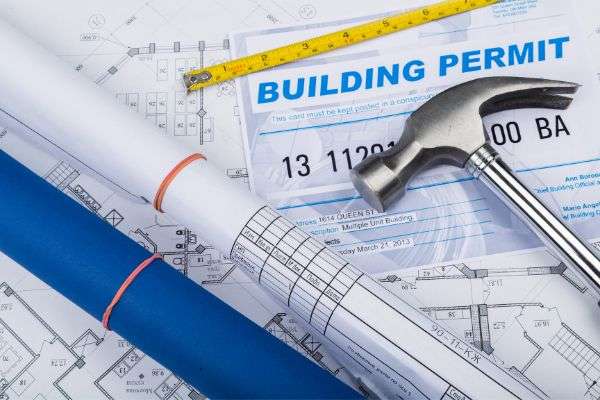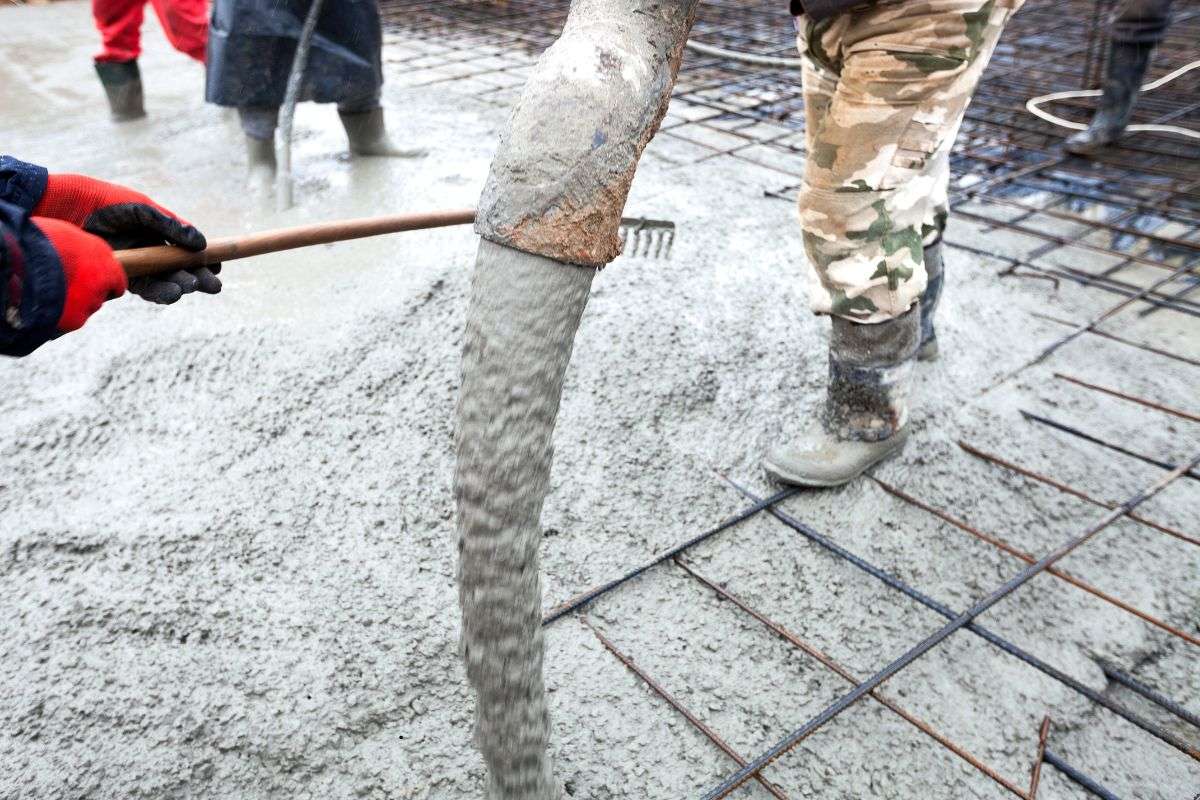The right concrete thickness for your metal building could save you thousands of dollars and years of headaches. Most metal building owners guess at concrete thickness and pay the price later. A foundation that’s too thin cracks under load, while one that’s too thick wastes money unnecessarily.
Your metal building’s concrete slab needs to be 4 to 6 inches thick depending on your specific use case. Light storage requires 4 inches, while heavy equipment demands 6 inches for proper support. Getting this decision right the first time prevents structural failures and costly repairs.
But thickness is just one piece of the puzzle that determines foundation success. Soil conditions, local codes, footing requirements, and proper anchoring all play critical roles. This complete guide shows you exactly how thick your concrete should be and reveals the other essential factors that ensure your metal building foundation lasts decades.

Planning Your Metal Building Foundation
Why Concrete Slab Thickness Matters
The thickness of your concrete foundation directly impacts your building’s structural integrity. Too thin, and your slab may crack under the weight of your metal structure. Too thick, and you’ll waste money on unnecessary materials and labor costs. Finding the right balance protects your investment while keeping construction costs reasonable.
Do You Need Building Permits?
Most metal building projects require permits, especially in areas with strict building codes. Requirements vary significantly based on your location and local regulations. Contact your local building department early in the planning process to understand requirements. Your concrete contractor should help guide you through the permit application process.
Many building suppliers provide engineer-approved plans to simplify permit applications. Smaller structures often come with standard plans included in the purchase price. Larger or more complex buildings may require custom engineering at additional cost. Always verify that your plans meet local code requirements before construction begins.
Understanding Foundation Regulations
Foundation regulations change based on your geographic location and intended building use. Most Midwest regions follow similar basic requirements for concrete foundations. Residential applications typically require minimum 4-inch thick slabs for standard vehicle use. Commercial and industrial buildings need 5-inch to 6-inch slabs for heavy equipment.
Footing depth requirements usually specify 42 inches below ground level minimum. Some local codes allow shallower footings based on soil conditions and climate. Footing width must be at least 12 inches to provide adequate support. Always check local frost line depths as they affect footing requirements.

Site Selection and Foundation Design
Selecting the Perfect Building Location
Multiple important considerations affect where you should position your metal building structure. Smart placement decisions impact convenience, safety, and long-term building performance significantly. Taking time to evaluate all factors prevents costly mistakes and future problems. Consider each element carefully to maximize your building’s functionality and value.
Property boundaries and setback requirements must be verified before selecting your location. Most municipalities require buildings to maintain specific distances from property lines. Contact your local zoning department to understand exact setback requirements for structures. Never place concrete slabs over septic systems, drain fields, or underground utilities.
Building accessibility directly affects your satisfaction and daily use of the structure. Choose locations that provide convenient access from your home and existing driveways. Consider how you’ll move equipment, vehicles, or materials in and out regularly. Position your building near electrical service points to reduce power installation costs.
Water Management and Drainage
Water drainage patterns require careful observation during site selection for optimal results. Watch where water flows and pools during heavy rain events throughout seasons. Avoid placing structures in low areas prone to flooding or standing water. Elevated locations with natural drainage protect your investment for many years ahead.
Standard Thickness Requirements
Most metal buildings require concrete slabs between 4 to 6 inches thick for optimal performance. Light-duty structures like small storage sheds can work with 4-inch slabs. Medium-weight buildings typically need 5-inch foundations for adequate support and durability. Heavy-duty industrial facilities often require 6-inch or thicker slabs to handle substantial loads.
Your concrete thickness must meet minimum standards based on intended building use. Standard storage applications require at least 4-inch thick slabs for adequate support. Heavy equipment storage demands 5 to 6-inch thickness to handle substantial loads. Always specify 4000 psi concrete strength for metal building foundations to ensure durability.
Choosing the Right Slab Size
Your concrete slab size depends on your specific building dimensions and design. Pay attention to frame dimensions versus roof dimensions when planning your foundation. Frame dimensions represent the actual building footprint you need to accommodate. Roof dimensions include overhangs and are typically 12 inches longer than frame.
Foundation sizing requires careful attention to proper clearances around your building perimeter. Your slab should extend at least 2 inches beyond your building width. This extra space accommodates wall thickness and provides better water drainage. Proper sizing prevents moisture problems and ensures adequate support for wall connections.
You have three main slab sizing options to consider for your project. Slope edge offset adds 1 inch around the perimeter with sloped drainage. This option provides excellent water management away from your building interior. Notched edge offset includes a lowered section at door locations for better drainage.
Edge flush sizing matches your exact building frame dimensions without extra space. This approach allows siding to overhang the foundation for weather protection. However, anchor installation may cause concrete edge chipping without proper techniques. Consider your drainage needs and installation methods when choosing slab sizing options.

Construction and Installation Details
Footing Requirements
Footing requirements play a crucial role in your foundation’s overall stability. Pour perimeter footings simultaneously with your slab for maximum structural integrity. Footings must be at least 12 inches wide and 12 inches deep minimum. Integrated footing and slab construction creates stronger foundations that resist settling issues.
How Metal Buildings Connect to Concrete Foundations
Proper anchoring systems secure your metal building safely to its concrete foundation. Engineering specifications determine the exact number and type of anchors required. Most buildings need anchoring systems rated for 120 mph wind loads minimum. Professional installation ensures your steel structure meets all safety and building code requirements.
Standard wedge anchor systems provide reliable connection between steel frames and concrete. Half-inch diameter by 7-inch length anchors handle most residential building applications. Engineers specify anchor placement patterns based on building size and local conditions. Quality anchors prevent structural movement during high winds and severe weather events.
Factors That Influence Slab Thickness
Several key factors determine your ideal concrete slab thickness beyond basic building weight. Soil conditions play a major role in foundation requirements and overall stability. Poor soil may require thicker slabs or additional reinforcement to prevent settling issues. Local building codes also dictate minimum thickness standards that must be followed.
Climate conditions in your area affect concrete performance and longevity significantly. Freeze-thaw cycles can damage thin slabs, requiring increased thickness in colder regions. The intended use of your building also influences thickness requirements considerably. Workshop spaces need thicker slabs than basic storage areas due to equipment loads.
Professional Planning and Execution
Start by consulting local building officials about code requirements in your area. Obtain soil tests to understand ground conditions and potential foundation challenges. Consider hiring a structural engineer for complex projects or unusual site conditions. Professional guidance ensures your foundation meets all safety and performance standards.
Calculate your building’s total weight including contents, equipment, and expected loads. Factor in safety margins to account for unexpected weight increases over time. Remember that proper planning prevents costly foundation repairs and structural problems later.
Conclusion
Your metal building’s foundation success depends on choosing the right concrete thickness for your specific needs. A 4-inch slab works for light storage in metal garages and carports, while heavy equipment demands 6 inches minimum. Beyond thickness, proper site selection, drainage planning, and professional installation ensure decades of reliable service. Don’t forget critical factors like footing depth, anchor systems, and local building codes. Investing time in careful planning now prevents expensive repairs and structural failures later. Whether you’re building a simple storage shed or industrial facility, the right foundation specifications protect your investment. Consult local building officials and consider professional guidance for complex projects. Your metal building deserves a foundation that matches its durability and strength. Make informed decisions about concrete thickness, reinforcement, and installation methods to create a structure that serves you well for generations.
Frequently Asked Questions
What is the most cost effective metal building size?
Smaller to mid-sized metal buildings (such as 30×40 or 40×60) are typically the most cost effective due to lower material, labor, and foundation costs compared to larger sizes.
Which metal building sizes are the most affordable to buy?
Standard sizes like 24×30, 30×40, and 40×60 often offer the best value, as manufacturers mass-produce these sizes and can pass on savings to buyers.
How does building size affect total project cost?
Larger buildings cost more overall but are usually cheaper per square foot. However, extremely large custom sizes may increase expenses due to engineering and material upgrades.
Can a smaller metal building meet my needs and save money?
Yes. Choosing the smallest size that meets your requirements can save significantly on materials, installation, and ongoing maintenance costs.
Are there ways to maximize value when choosing a size?
Yes, consider future expansion options and compare package deals from multiple suppliers to find the best combination of size, quality, and price.


